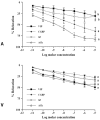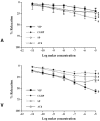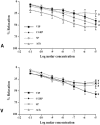Role of endothelium and nitric oxide in modulating in vitro responses of colonic arterial and venous rings to vasodilatory neuropeptides in horses
- PMID: 15971675
- PMCID: PMC1142178
Role of endothelium and nitric oxide in modulating in vitro responses of colonic arterial and venous rings to vasodilatory neuropeptides in horses
Abstract
The objective of this study was to determine and compare the in vitro responses of equine large colon arterial and venous rings to vasodilatory neuropeptides; calcitonin gene-related peptide (CGRP); substance P (SP); vasoactive intestinal polypeptide (VIP); and acetylcholine (ACh), a standard nonpeptide endothelium-dependent vasodilator. Responses of vessel rings to graded concentrations (10(-11) M to 10(-5) M) of each drug were determined in endothelium-intact, denuded, and Nomega-nitro-L-arginine methyl ester (L-NAME, 10(-5) M)-treated rings that were pre-contracted with norepinephrine. Percentage maximal relaxation (PMR), defined as the % decrease from the contracted state, was determined. Because all rings did not relax at least 50%, EC50 values could not be consistently calculated. Arterial rings with intact endothelium were more sensitive to CGRP, compared with VIP and SP, and venous rings of all conditions were more sensitive to VIP than CGRP or SP. Overall, arteries had a greater PMR for ACh compared with SP and VIP. Intact and L-NAME treated arteries had a greater PMR than denuded arteries; there were no differences in PMR of intact and L-NAME treated arteries. Veins had a greater PMR for VIP than CGRP, SP, or ACh. Calcitonin gene-related peptide caused greater relaxation in intact arteries, whereas VIP causes greater relaxation in veins. Arterial relaxation was dependent upon the presence of intact endothelium. The response of veins to VIP among the conditions tested was not different, suggesting VIP has direct actions on venous smooth muscle. These neuropeptides modulate vasomotor tone via vasorelaxation in colonic arteries and veins.
Cette étude avait comme objectif de déterminer et comparer les réponses in vitro d’anneaux artériels et veineux provenant du gros côlon équin à des neuropeptides vasodilatateurs comme le peptide apparenté au gène de la calcitonine (CGRP); la substance P (SP); le polypeptide intestinal vaso-actif (VIP); et l’acétylcholine (ACh), un vasodilatateur standard non-peptidique. Les réponses des anneaux de vaisseaux à des concentrations graduées (10−11 M à 10−5 M) de chaque drogues on été déterminées avec des anneaux à endothélium intact, dénudé, et traité avec du Nω-nitro-L-arginine méthyl ester (L-NAME, 10−5 M) pré-contractés avec de la norépinéphrine. Le pourcentage de relâchement maximal (PMR), défini comme le pourcentage de réduction à partir de l’état contracté, a été déterminé. Étant donné que les anneaux ne se sont pas tous relâchés d’au moins 50 %, les valeurs de EC50 n’ont pu être calculées de manière constante. Les anneaux artériels à l’endothélium intact étaient plus sensibles au CGRP, comparativement au VIP et SP, et toutes les préparations d’anneaux veineux étaient plus sensibles au VIP qu’au CGRP ou au SP. Pour les artères, un plus grand PMR a été observé avec l’ACh qu’avec SP et VIP. Les artères à l’endothélium intact ou traité avec L-NAME montraient un plus grand PMR que les artères à endothélium dénudé; et il n’y avait pas de différences du PMR entre les artères à endothélium intact et celles traitées avec L-NAME. Les veines avaient un PMR plus grand avec le VIP qu’avec le CGRP, le SP ou l’ACh. Le CGRP entraînait une plus relaxation plus marquée dans les anneaux artériels à endothélium intact, alors que le VIP produisait une plus grande relaxation dans les anneaux veineux. La relaxation artérielle était dépendante de la présence d’un endothélium intact. Les réponses des anneaux veineux au VIP dans les différentes conditions testées n’étaient pas différentes, ce qui suggère que le VIP a une action directe sur le muscle lisse veineux. Ces neuropeptides modulent la tonicité vasomotrice via la vaso-relaxation des artères et veines du côlon.
(Traduit par Docteur Serge Messier)
Figures



References
-
- Granger DN, Kvietys PR, Korthius RJ, Premen AJ. Microcirculation of the intestinal mucsoa. In: Scultz SG, Wood JD, Rauner BB, eds. Handbook of Physiology. Section 6: The Gastrointestinal System. Bethesda, Maryland: American Physiological Society, 1989:1405–1474.
-
- Moore RM, Muir WW, Bertone AL, Beard WL. Characterization of the hemodynamic and metabolic alterations in the large colon of horses during low-flow ischemia and reperfusion. Am J Vet Res. 1994;55:1444–1453. - PubMed
-
- Moore RM, Hardy J, Muir WW. Mural blood flow distribution in the large colon of horses during low-flow ischemia and reperfusion. Am J Vet Res. 1995;56:812–818. - PubMed
-
- Moore RM, Bertone AL, Muir WW, Beard WL, Stromberg PC. Histopathologic evidence of reperfusion injury in the large colon of horses after low-flow arterial ischemia. Am J Vet Res. 1994;55:1434–1443. - PubMed
-
- Provost PJ, Stick JA, Patterson JS, Hauptman JG, Robinson NE, Roth R. Effects of heparin treatment on colonic torsion-associated hemodynamic and plasma eicosanoid changes in anesthetized ponies. Am J Vet Res. 1991;52:289–297. - PubMed
Publication types
MeSH terms
Substances
LinkOut - more resources
Full Text Sources
Research Materials
